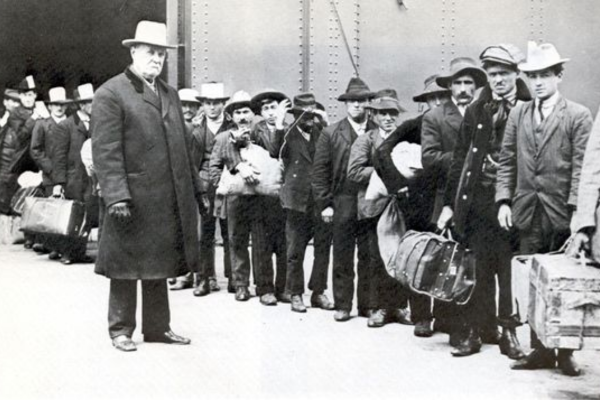Italian immigration to the United States began in the late 19th century and continued into the early 20th century. It was one of the largest waves of immigration in U.S. history, with over 4 million Italians immigrating to the U.S. between 1880 and 1920.
The reasons for the influx of Italian immigrants were varied. One of the main reasons was economic hardship in Italy. Many Italians were poor and struggled to make a living in their home country. Additionally, political instability and the lack of job opportunities made it difficult for many Italians to support themselves and their families.
However, the promise of a better life in America was a major draw for Italian immigrants. The U.S. was seen as a land of opportunity, where hard work and determination could lead to success. Many Italian immigrants were also motivated by the prospect of reuniting with family members who had already immigrated to the U.S.
The impact of Italian immigration on American society was significant. Italian immigrants brought with them their culture, traditions, and cuisine, which have had a lasting influence on American society. Italian food, in particular, has become a beloved part of American cuisine, with pizza and pasta being popular dishes in households across the country.
Italian immigrants also made significant contributions to American industry and helped shape the country’s economy. Many Italians worked in factories and mines, contributing to the growth of the American manufacturing industry. Italian Americans have also played a prominent role in politics, entertainment, and sports, with figures such as Frank Sinatra, Al Pacino, and Joe DiMaggio becoming cultural icons.
Despite facing discrimination and prejudice, Italian immigrants have made significant contributions to American society and helped shape the country into what it is today. Their legacy lives on through their descendants and the enduring influence of Italian culture on American life.
The Early Years
The first wave of Italian immigrants to the United States began in the late 1800s, when Italy was experiencing extreme poverty, political turmoil, and high unemployment rates. Between 1880 and 1920, over four million Italians immigrated to the United States in search of better opportunities and a brighter future. Many of these immigrants were from Southern Italy and Sicily, and they faced numerous challenges upon arrival in America.
One of the biggest challenges facing Italian immigrants was discrimination. They often faced prejudice and hostility from native-born Americans, who viewed them as inferior and unwelcome. Additionally, many Italian immigrants lived in overcrowded tenements in urban areas, with poor living conditions, low-paying jobs, and limited access to education and healthcare. Despite these obstacles, Italian immigrants persevered and made significant contributions to American society.
Contributions to American Society
Italian immigrants brought with them a rich cultural heritage, including their language, food, music, and art. They also played a vital role in building America’s infrastructure, including the construction of railroads, bridges, and tunnels. Italian immigrants also made significant contributions to the arts, sciences, and politics. For example, Antonin Scalia, the first Italian-American Supreme Court Justice, was appointed in 1986.
Italian immigrants also played a pivotal role in shaping America’s culinary identity. Pizza, spaghetti, and meatballs are now considered American staples, but they were introduced to the United States by Italian immigrants in the early 1900s. These dishes quickly gained popularity and became an important part of American cuisine. Today, Italian-American chefs are some of the most celebrated in the country, with restaurants across the United States serving delicious Italian fare.
Overall, the contributions of Italian immigrants to American society cannot be overstated. Despite facing numerous challenges, they brought with them a rich cultural heritage and a strong work ethic, which helped shape America into the diverse and vibrant nation it is today.
Italian immigrants to the United States faced many challenges upon arrival, including discrimination, poor living conditions, and limited opportunities. Despite these obstacles, they persevered and made significant contributions to American society, including in the areas of infrastructure, cuisine, and politics. Italian immigrants brought with them a rich cultural heritage, which has become an integral part of American society and helped shape the nation into the diverse and vibrant place it is today.
Niche Topics
The role of Italian immigrants in the development of the American Mafia
Italian immigrants played a significant role in the development of organized crime in America, particularly the Mafia. They brought with them a culture of secrecy, loyalty, and family that would become the backbone of the Mafia. The first Italian criminal organizations were formed in the late 19th century in New York City, primarily for self-protection against other ethnic groups.
Over time, these groups evolved into what we now know as the American Mafia, with Italian immigrants at the helm. The Mafia became a powerful force in American society, involved in illegal activities such as gambling, drug trafficking, and extortion. Despite the efforts of law enforcement, the Mafia continued to thrive throughout the 20th century, largely due to the loyalty and secrecy ingrained in its culture.
One of the most famous Italian-American Mafiosos was Al Capone, who rose to power during the Prohibition era. Capone controlled a vast criminal empire that included bootlegging, gambling, and prostitution. He became a notorious figure in American pop culture, and his legacy still fascinates people today.
Despite the negative impact of the Mafia on American society, it is important to acknowledge the contributions that Italian immigrants made to the development of organized crime in America. Their culture of loyalty and family, while ultimately used for nefarious purposes, was a significant factor in the rise of the American Mafia.
The impact of Italian cuisine on American cuisine
Italian cuisine has had a profound impact on American cuisine, with Italian dishes now a staple in many American households. Italian immigrants brought with them a love of food and a passion for cooking, which they passed down through the generations. Today, Italian food is one of the most popular types of cuisine in America, with pizza and pasta being particularly beloved.
Italian immigrants also introduced new ingredients to American cuisine, such as tomatoes, which were not commonly used in American cooking before the arrival of Italian immigrants. Italian cuisine also emphasizes the use of fresh, simple ingredients, which has influenced the way Americans cook and eat.
Italian-Americans have also made significant contributions to American cuisine, with Italian-American chefs such as Mario Batali, Lidia Bastianich, and Giada De Laurentiis becoming household names. Italian-American cuisine is now a distinct type of cuisine, blending traditional Italian dishes with American ingredients and cooking techniques.
The influence of Italian art on American art
Italian art has had a significant influence on American art, particularly during the Renaissance period. Many Italian artists, such as Leonardo da Vinci and Michelangelo, were celebrated for their skill and creativity, and their influence can be seen in American art to this day.
Italian-Americans have also made significant contributions to American art, with Italian-American artists such as Frank Stella, Joe DiMaggio, and Tony Bennett becoming household names. Italian-American art is now a distinct type of art, blending traditional Italian styles with American themes and techniques.

Italian art has also influenced American architecture, with Italian Renaissance architecture inspiring many American buildings such as the Library of Congress and the Jefferson Memorial in Washington, D.C.
Lesser-Known Details About Italian Immigration
While Italian immigration to the United States is a well-known part of America’s history, there are several lesser-known details that are often overlooked. For example, the experiences of Italian immigrant women are often ignored, despite their significant contributions to their families and communities.
The Experience of Italian Immigrant Women
Italian women who immigrated to the United States faced unique challenges and opportunities. Many women worked in factories or as domestic servants, and their wages were often vital to their families’ survival. However, they also faced discrimination and exploitation, with many being paid less than their male counterparts for the same work.
Despite these challenges, Italian immigrant women played a crucial role in their communities. They were often responsible for maintaining cultural traditions and passing them down to future generations. They also played a significant role in the labor movement, fighting for better working conditions and higher wages for themselves and their families.
The Role of Italian Immigrants in the Labor Movement
Italian immigrants played a crucial role in the American labor movement, particularly in the early 20th century. They were heavily involved in unions and strikes, fighting for better wages, working conditions, and safety standards.
In 1911, the Triangle Shirtwaist Factory fire in New York City claimed the lives of 146 garment workers, mostly women. Many of the victims were Italian immigrants, and their deaths galvanized the labor movement and led to significant reforms in workplace safety and labor laws.
The Discrimination Faced by Italian Immigrants
Despite the significant contributions made by Italian immigrants to American society, they faced discrimination and prejudice from many Americans. They were often stereotyped as criminals or members of organized crime, and were subjected to discrimination in employment, housing, and education.
This discrimination was particularly pronounced during World War II, when Italian Americans were subjected to internment and surveillance due to their perceived allegiance to Italy. It wasn’t until the 1960s and 70s that Italian Americans began to gain greater acceptance and recognition in American society.
Overall, the experiences of Italian immigrants in the United States were complex and multifaceted. By exploring these lesser-known details, we can gain a deeper understanding of the challenges and triumphs that they faced, and the lasting impact that they have had on American society and culture.



